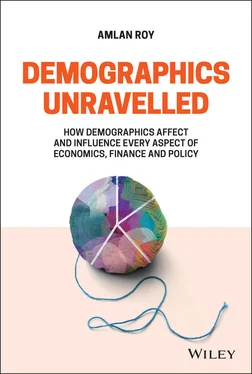My most important debt is to my lovely family, who have always supported me: my wife Anjana and daughters Antara and Anusha. My late aunt Subhanjali Sarkar and cousin Chitralekha were pillars of strength through many troubled times in the past, so I also owe a lot to them. And thanks to all those who have been pressuring me over the last eight years to write a book on demographics.
Finally, I would like to thank Gemma Valler and Purvi Patel of Wiley for their guidance. A very special thanks to Tiffany Taylor for excellent editorial work in improving the book's readability. Gladys Ganaden created the nice cover design. Daughter Antara chose the final cover image. Thanks to Ashok Ravi who provided tips for efficient edits at final stage.
I hope that this book contributes to inspiring readers to broaden their views and perspectives in more fields than just demographics. Viewing data and events from multiple angles provides additional richness to our insights.
This book is about my interpretation of demographics and its manifest implications for investments, macroeconomics, and policy. It represents more than two decades of research and synthesizes the connectivity of demographics with several subfields of economics: history, macroeconomics, international economics, labour economics, monetary policy, financial economics, development economics, etc. Repeated requests from clients, friends, and family, especially over the last eight years, have been the motivation for this book. My perspective is largely uniquely mine and like that of Peter F. Drucker 1 .
I draw on my teaching and reading across various subdisciplines of economics and finance to make demographics relevant for investment practitioners, policymakers, and applied researchers. My research notes have made this discipline relevant across different asset classes (equities, fixed income, real estate, commodities, alternatives) and geographies. This allowed for creation of investment products and funds based on the applied research. I challenge many conventional perceptions as being narrow and at best partially correct, offering multiple examples.
I believe that demographics pertains to each individual on the planet and not just the young or the old. I also highlight differences across old countries and old individuals, cautioning against blanket generalizations as the only defining criterion. The idea in the book is to explain relationships between demographic variables and economic as well as financial variables in an intuitive and consistent fashion. Wherever possible data, models, and frameworks are used to embellish the ideas.
In the spirit of a “Brave New World” 2 , this book challenges convention, expanding the boundaries of thought for understanding the real world of economics, investments, and policy options across multiple generations. It brings together macro and investment insights holistically with implications for individuals, companies, and countries. It discusses the important area of intergenerational fairness in a world where up to four or five generations co-exist for the first time in human history. Social responsibility and gender equality are at the core of important policy issues I discuss for a braver, better world. I hope the ideas in this book inspire discussion, debate, and understanding of issues that are critical for a better future society.
The structure of the book is as follows:
1 Introduction. This chapter introduces and amplifies a broader, more insightful perspective of demographics. It presents the layout and chapter sequence with a few sentences to highlight the key issues, major take-aways, and challenges to a traditionalist perspective. It should encourage readers to go to specific chapters on a deeper dive to unravel various strands of demographics.
2 Global demographic trends. This chapter summarises key trends with links to major public data sources. The purpose of highlighting these trends is to shed new light on several issues that readers broadly know of but often misinterpret or miss the point of. Age distributions (population pyramids), fertility, life expectancy, old-age dependency ratios, migration rates, gender ratios, etc. are presented and discussed. The focus is on the more important differences that are typically glossed over in order to aggregate countries, regions, and cities on some common feature. For example, what are the key differences across similar-looking Nordic countries; or open economies like Singapore, Taiwan, etc.; or smaller countries in the Middle East; or the US vs. Canada or the EU4? This chapter shows why certain commonly used and aggregated metrics or indicators may be misleading. Why are the largest advanced countries different from each other in important ways? The pace of urbanisation and growth of megacities have implications for sustainability, human development, health, and education. The concept of demographic transition, which interacts with economic cycles and affects all aspects of human life worldwide, is also discussed. Data differences and interpretation provide motivation for further discussions in later chapters.
3 Macroeconomics: This chapter shows how characteristics and behaviour of consumers and workers affect economic growth, living standards (GDP per capita growth), inflation, and unemployment. Demographic effects are not just long-term, as these factors are also short-term variables. Consumers and workers make decisions throughout their lives, not just for the long-term. Understanding the implications for public debt, savings, and capital flows is vital to develop better policies and make optimal decisions. Economic growth is related to growth in worker numbers, worker productivity, and hours worked. I discuss why labour productivity growth is key to reviving global GDP growth in the developed world as well as major fast-growing emerging markets. Gender equality and youth empowerment are potential solutions to greater economic output. It is argued that long-term ageing-related promises are unsustainable in a lower-growth world and need renegotiation for fairer intergenerational equity. The chapter discusses the potential realisation of the demographic dividend across emerging and developed economies.
4 Asset prices: This chapter discusses how demographics affects equity, bonds, real estate, and commodities in terms of asset prices and returns. The chapter presents insights from the academic literature on allocating accumulated resources over the human lifetime. Workers and retirees are faced with longer retirement periods, lower average growth, “lower for longer” interest rates, lower investment returns (equity, corporate bonds, high yield, etc.), and lower inflation than in the past. Investment returns and asset prices are influenced by consumption, savings, and investment decisions of households. Governments are faced with the responsibility of ensuring lower poverty rates for retirees in the future. The chapter presents the links between demographics and equity premia, sovereign bond yields, and sovereign ratings and also highlights equity sectors that are demographically advantaged and likely to emerge as winners.
5 Longevity and health: This chapter provides insights into and discusses the reasons for uncertainty regarding longer horizon resource planning for individuals and institutions. The emphasis on good health and importance of public health investments has been continuous throughout the ongoing COVID pandemic. The need to focus on healthy life expectancy and disability-adjusted life years rather than life expectancy at birth is emphasised. It is also important to know how longevity uncertainty and longevity risk management can be improved to enjoy a healthy and adequate retirement life. The models of longevity and instruments to defray longevity risk (the risk of outliving accumulated savings) need to be better understood by institutions (pension funds, reinsurers, insurance companies) to manage assets to meet longevity-related obligations (liabilities).
Читать дальше












